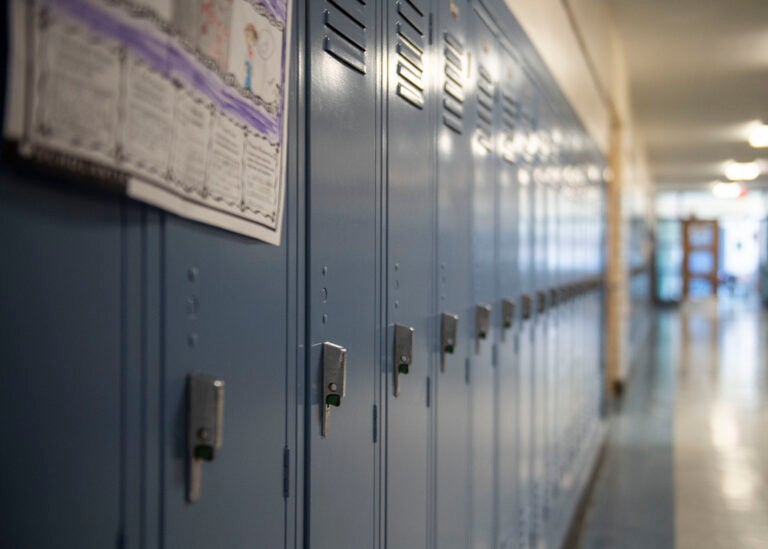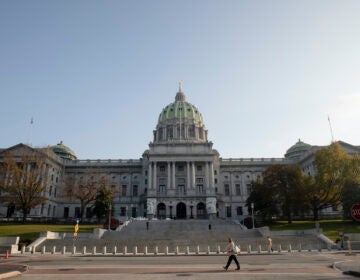A disagreement about measuring student poverty is delaying the Pa. budget
That’s a key issue for public school advocates, who see this year’s budget as critical to eliminating the funding gap between rich and poor districts.

Bennetts Valley Elementary School on April 5, 2023. (Nate Smallwood / For Spotlight PA)
This story originally appeared on Spotlight PA.
More than a week after the deadline to complete the budget, Pennsylvania lawmakers remain at odds over how much additional funding to send to the state’s public schools.
And in recent days, legislative leaders say a new issue has emerged: picking which data to use to determine the schools most in need of supplementary money. While that may seem like a minor detail in a budget expected to exceed $48 billion, one expert said a wrong decision could fall short of addressing a landmark court ruling and deprive poor districts of needed dollars.
In that 2023 decision, a Commonwealth Court judge found the state’s education funding system harms poor students and ordered lawmakers to make it more equitable while stopping short of prescribing a remedy.
Gov. Josh Shapiro and legislative Democrats are backing a plan that would route billions of additional dollars to poor rural and urban districts alike. They’ve placed the price tag at $6 billion, and state House Democrats have introduced legislation that would dole that funding out over seven years.
Legislative Republicans broadly agree the state should increase public education spending but want a much smaller number than Democrats. They also want to be able to negotiate the funding amount every year, which would ensure the issue remains a bargaining chip.
In a news conference last week, state Senate Majority Leader Joe Pittman (R., Indiana) said Republicans are focused on “how those dollars get driven to school districts,” in addition to total education spending.
That’s a key issue for public school advocates, who see this year’s budget as critical to eliminating the funding gap between rich and poor districts.
The Democratic-backed education plan would send $5.1 billion to 371 school districts with “adequacy gaps.” This measure sets a baseline amount of per-student spending, then adds in additional spending based on a district’s student body and factors like poverty and level of English proficiency.
Poverty would be determined by census data but also by data that districts report on student eligibility for programs like cash assistance or Medicaid. The state Department of Education tells districts how to collect the data, which are currently used to evaluate schools.
Public education advocates argue this is key information since it’s difficult to capture the amount of poverty in a district with census data that uses a small sample size and includes children who aren’t sent to public schools.
During the news conference, Pittman said Republicans “firmly believe that the census data is a critical piece to making sure that the dollars are driven out in an accurate manner.” He appeared wary of data that would be self-reported by districts, pointing to concerns from stakeholders including Department of Education staff highlighted in a GOP-backed education funding report.
He provided few details about how Republicans would redesign the state’s funding formula, and a spokesperson did not respond to Spotlight PA’s request for further comment.
“There’s some hard reality setting in that whenever you build a formula, some benefit more than others,” Pittman said at the news conference.
Excluding in-school poverty data will yield a less accurate picture of the poverty facing students, Donna Cooper, a former top gubernatorial staffer and public education advocate, told Spotlight PA.
That approach, she said, seems designed to circumvent the equity requirements in last year’s court ruling by artificially lowering the amount of money that would be sent to hundreds of the state’s school districts with poorer student bodies.
She also noted that the census data preferred by Pittman, the American Community Survey, is self-reported.
“If the lawmakers with a $15 billion surplus wanted to find agreement, this kind of small, formulaic issue would not be on the table, especially since it’s not based in sound policy,” Cooper said.
Speaking to reporters Monday, state House Appropriations Committee Chair Jordan Harris (D., Philadelphia) downplayed the divide over education data, calling it “a difference of views and opinions that we’re massaging.”
He declined to discuss the details of the negotiations.
This is the state’s third straight late budget. Lawmakers are navigating how to spend a roughly $15 billion surplus built during the pandemic due to federal stimulus money and higher-than-expected tax returns.
Along with education, potential sticking points include transit funding, energy policy, and tax cuts. Republicans are pushing for a cut to Pennsylvania’s income tax and the elimination of a tax on private utility companies.
Most of the state’s day-to-day operations aren’t affected by a late budget. Government employees are paid, debt payments are made, and state money continues to flow to health care payments for low-income individuals. However, if budget negotiations stretch into late summer, local governments, schools, and nonprofits could start to feel fiscal pain.
In 2022, the budget was a week and a half late as former Democratic Gov. Tom Wolf negotiated a deal with the then-Republican-controlled General Assembly to increase funding for schools, parks, and housing.
In 2023, a much longer impasse occurred after Shapiro vetoed $100 million for private school vouchers to earn the support of the newly Democratic state House. He incensed state Senate Republicans, who said he had reneged on a deal, and the spending plan wasn’t finalized until December.
How 2024 will turn out is still unclear. Capitol sources say talks continued over the weekend on education and taxes. As of Monday, legislative leaders had not announced a deal but did express optimism.
In a statement last week, Shapiro spokesperson Manuel Bonder said that the governor “has been engaged in a positive, productive dialogue in Harrisburg with leaders in both parties” and that Shapiro is “grateful that all sides have remained at the table, understand the need to compromise.”
“It’s literally like fine-tooth, making sure all t’s are crossed and i’s are dotted at this point,” Harris said Monday.

Get daily updates from WHYY News!
WHYY is your source for fact-based, in-depth journalism and information. As a nonprofit organization, we rely on financial support from readers like you. Please give today.





